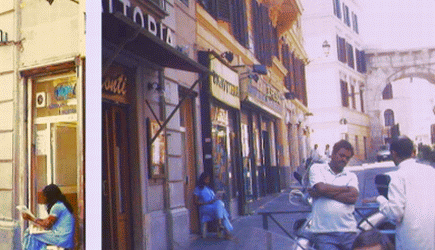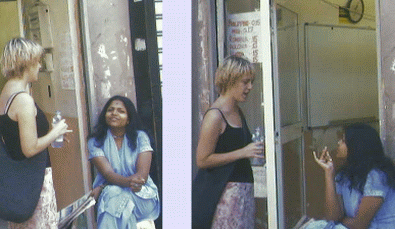

|
NEW
WINDOW: To see the presentation, click on the numbers
from 1 to 20 above. |
|
|
|
|
|
|
All
slides and bibliographies appear on the web at: sietar.boylan.it
(no “www”).
It is therefore unnecessary to take any
notes during the presentation.
.
To
see the presentation, click on the numbers from 2 to 20
above.
Given
the requirements of our tertiary, global economies,
knowing how to
communicate in any language
means knowing how to:
-
manage on-going
co-constructed meaning-making in situ,
whether
with native speakers or lingua franca users,
-
relate culturally
(existentially) to interlocutors in English,
not
just explain concepts to them,
-
share values through
English seen as a behavioural matrix
(Which
values? Theirs/ours/those of mutually created third spaces)
To
see the presentation, click on the numbers from 3 to 20
above.
Given
the requirements of our tertiary, global economies,
knowing
how to communicate in any language
means knowing how to:
-
manage on-going
co-constructed meaning-making in situ,
whether
with native speakers or lingua franca users,
-
relate culturally
(existentially) to interlocutors in English,
not
just explain concepts to them,
-
share values through
English seen as a behavioural matrix
(Which
values? Theirs/ours/those of mutually created third spaces)
To
see the presentation, click on the numbers from 4 to 20
above.
Given
the requirements of our tertiary, global economies,
knowing
how to communicate in any language
means knowing how to:
-
manage on-going
co-constructed meaning-making in situ,
whether
with native speakers or lingua franca users,
-
relate culturally
(existentially) to interlocutors in English,
not
just explain concepts to them,
-
share values through
English seen as a behavioural matrix
(Which
values? Theirs/ours/those of mutually created third spaces)
To
see the presentation, click on the numbers from 5 to 20
above.
Given
the requirements of our tertiary, global economies,
knowing
how to communicate in any language
means knowing how to:
-
manage on-going
co-constructed meaning-making in situ,
whether
with native speakers or lingua franca users,
-
relate culturally
(existentially) to interlocutors in English,
not
just explain concepts to them,
-
share values through
English seen as a behavioural matrix
(Which
values? Theirs/ours/those of mutually created third spaces)
This
new "need-to-know" requires specialists in
communication
but also in languages as culture.
A
new definition of language: As the expression of a culture,
a
language is a shared, historically-rooted will to
mean
expressing a shared, historically-rooted will
to be (or “culture”).
Who
can prepare such specialists?
University
language centres?
But
they teach English as “decoding texts”.
Unless...
University
degree courses in languages?
But they teach English as
textual realizations. Unless...
Company
training courses in Intercultural Communication?
But they
tend to ignore language;
they teach communication as behavioural
recipes. Unless...
Teaching
languages as culture
(or
teaching Intercultural Communication linguistically)
for
example, by making learners ethnographers
Boylan,
P. (1980) L'apporto dell'antropologia
linguistica all'insegnamento delle lingue straniere. In:
SLI, Lingua e Antropologia, Bulzoni, Roma, 1983, pp.
497-509.
Boylan, P. (1998) Being one of the
group. VI IPrA Conference (Reims) Manuscript available: www.boylan.it
under “Research”
Roberts,
C. (2000) Language learners as ethnographers.
Clevedon: Multilingual Matters.
Byram, M. (2001)
Developing Intercultural Competence in Practice, Clevedon:
Multilingual Matters, 2001


Variations
in subject's response (formality/informality,
distance/intimacy)
correlated with variations in language (Br.Eng.
/ “Indian English”)
Eva
did not an attempt to use the phonology and lexico-syntax of
Indian English (the variety we hear Gandhi use in documentaries).
Instead, Eva internalized Gandhi's mind-set and expressive stance,
then spoke spontaneously. Since language is a certain "will
to mean"
deriving from a certain "will
to be",
this sufficed to create a rapport with her interlocutor.
See
www.boylan.it
for bibliographies,
syllabi, tasks for each course taught.
Type
of ethnographic questioning conducted
by
University of Rome III students (Course in English
for Intercultural Communication):
not
quantitative, positivist questioning* which
-
“constructs and constrains the answers” (Roberts,
2001)
- makes the “strange” familiar...
but
qualitative, hermeneutic questioning** which
-
requires a transformation of consciousness to grasp what is
“strange”
- makes the “strange”
genuinely “strange.”
*Oppenheim,
A. (1992), Questionnaire design, interviewing, and attitude
measurement,
London: Continuum.
**
Spradley, J. (1979), Ethnographic Interview, New York: Holt
Rinehart & Winston
Agar, M. (1996),
Language Shock: Understanding Culture, New York: Morrow.
What
are the theoretical underpinnings for this
- method of inquiry into the various cultures
-
which is also a way of describing
expressive habits
- and is also a method of teaching each variety of language as a mode of “relating”, of “sharing values”, of co-constructing meanings in situ and in real time?
Making
the familiar strange (and making
that strangeness genuinely so):
the
Chicago school of Urban ethnography during the Depression years
Why the term “urban ethnography”? Because normally ethnographers study tribes in the jungle. The Chicago sociologists saw that tribes exist in the city as well (for example, the criminal underworld, tramps and gypsies, religious cults), each with its own language, that could be studied with ethnographic methods.
"Sociologists
at the University of Chicago turned out a series of studies based on
investigations into their own city which have been generally
recognized as the beginning of modern urban studies, and as the most
important body of social research on any single city in the
contemporary world."
(Hannerz, 1980)
slum
inhabitants - Zorbaugh, H. W. (1929). The Gold Coast
and the Slum,
Chicago:
University of Chicago Press.
taxi-hall dancers
- Cressey, Paul (1932). The Taxi Hall Dance.
Chicago:
University of Chicago Press.
juvenile gangs -
Shaw, C. & H. McKay. (1942). Juvenile Delinquency and
Urban
Areas. Chicago: Univ. Press.
Purpose:
to unmask...
...how
societies create the “odd” and the “normal”
...how
societies base presumptive knowledge on stereotyping and
implicit
cultural categories (and thus do not understand
the Others in themselves).
But
these are the same mechanisms encountered in language courses!
They
are the mechanisms of projection and stereotyping
that keep language learners from really understanding the semantic
values of the L2 words
they are studying, or how they themselves
harbour – somewhere
within themselves – the Otherness of the culture
they are studying.
See Coleman (1998) on returning ERASMUS students who saw only what they went to see and whose categories of “odd” and “normal” remained unchanged by their foreign sojourn. Clearly, these students did not know how to use their L2 to grasp and share new values “from the natives' point of view” (Malinowski, 1961 [1922]), i.e. ethnographically. So can it really be claimed that they “understood” their L2 interlocutors abroad? Can it really be claimed that they “understand” their L2 at all, even if they get good marks in listening comprehension tests?
End
of the Depression (1939) = end of urban
ethnography
In
studying marginal social figures, sociologists turned to
functionalism,
neo-positivism
(i.e.,
from “understanding them” to “understanding how to
manage them”)
Brief
resurgence of “Critical ethnography” (post '68)
"Chicago
Irregulars": Faris, 1970; Carey, 1975;
Lofland, 1980...
plus
Schutz's students* at the New School for Social Research
*We
can include H. Garfinkel (Studies in Ethnomethodology, 1967),
a student of T. Parsons and inventor of the “students as
boarders in their own home” technique to unmask social
structures in home life. He developed ethnomethodology through
correspondence with Schutz.
Teaching
languages as culture using
urban ethnography
i.e.,
by interviewing members of the L2 “tribes” one may find
in one's home town
(Example:
in Rome the British community may be found in the churches, schools,
etc. it has there.)
Warning
The same shift is occurring in
this field as happened in Chicago:
from understanding one's foreign interlocutors from their point of view
to learning to manage one's social and economic exchanges with them.
The shift covers the three major paradigms of urban ethnography: (1.) “Making the strange familiar” – i.e., projecting your schemes on it, which is the dominant paradigm today; (2.) “Making the familiar strange” – learning to see your own culture as problematic, e.g. Garfinkel's “student boarder” experiments; (3.) “Making the strange genuinely strange” – learning to see life “from the natives' point of view”, e.g. the Chicago school 1929-39.
You can trace the various currents in Byram, Kramsch, Zarate.
Case in point:
Picture
(Promoting
Intercultural Communication Through Using
Real Experiences)
E.U.
Project – 18 universities and language centres in 12 countries
–
launched February, 2005, at the Language Centre of the
University of Amsterdam, under the direction of Cor Koster.
Purpose:
introduce the ethnographic approach to language learning into
EU university courses and language labs through a 20 hour module
based on CD ROM material, model questionnaires and a Teacher's Guide.
The module teaches L2 students to interview, in their home towns, L2
speakers on visit or who live there, and define their cultural
stance.
Unresolved question: which urban ethnography
approach to use?
Example:
the PICTURE CD module used by French employees
at SIEMENS
(Sophia/Nice) who are studying English (or German)
Should
the subjects they interview ethnographically be:
-
French? (so that the employees, before internalizing the
Anglo mind set, first learn to “distance” themselves from
their own culture)
- English or German visitors
to Nice? (to grasp the mind-set of an English or German
speaking interlocutor through interaction and through ethnographic
questioning)
But who counts as an “English”
or “German” speaking interlocutor”?
- Swedes
who speak perfect Standard BrEng? LFE (Lingua franca
English) ÖsDe SchuleDe ?
- Pakistanis speaking
perfect Pakistani Eng? Berliner Turks speaking
perfect TürkischeDe?
-
British or German expatriates who, over time, may mutate
culturally?
(The
PICTURE project is developing a series of guidelines.)
Current
debate on the scope of the ethnographic study.
Should
it:
-
document interviewees' use of language (e.g., their English or
German)
as revealing their cultural assumptions (an
ethnolinguistic study)?
-
document cultural values directly and if so how?
-
cultural dimension questions?
- critical
incident questions?
Whose? The
incidents French people have in in the U.K. or in Germany?)
The
incidents that British or German vistors have in France (Nice)?
-
document what to say or why to say it in X's culture?
-
document how to act or what values to have in X's culture?
-
document responses to a universal questionnaire on opinions and
attitudes (like The European
Values Study www.europeanvalues.nl)?
Answers
depend on theoretical framework:
What
does it mean to “communicate”?
What does it mean to
“communicate interculturally”?
How
do we know that we understand a communicative intent?
What
is language and what is culture?
Whose English/German should be
used in exchanges conducted in English/German?
Should
I, a French employee at Siemens (Nice), use “my”
English? The Queen's English?
A Lingua Franca English
(koiné) Hoch
Deutsch? Bayerische Deutsch?
Or should I try to use your English or German,
defined as the will to mean
you share with your community,
based on your shared will to be?
What
questioning (or silence) best promotes understanding?
Answers
also depend on practical issues:
How
ready are EU teachers to accept a novelty like this?
Might it be
more strategic to start with positivist style questioning, then, if
accepted, issue a second CD teaching hermeneutic questioning?
Thank you for participating.
Bibliography
(prepared
by Cor Koster of the PICTURE project)
For the bibliography of texts given to students to read in courses, see the individual courses under TEACHING at www.boylan.it